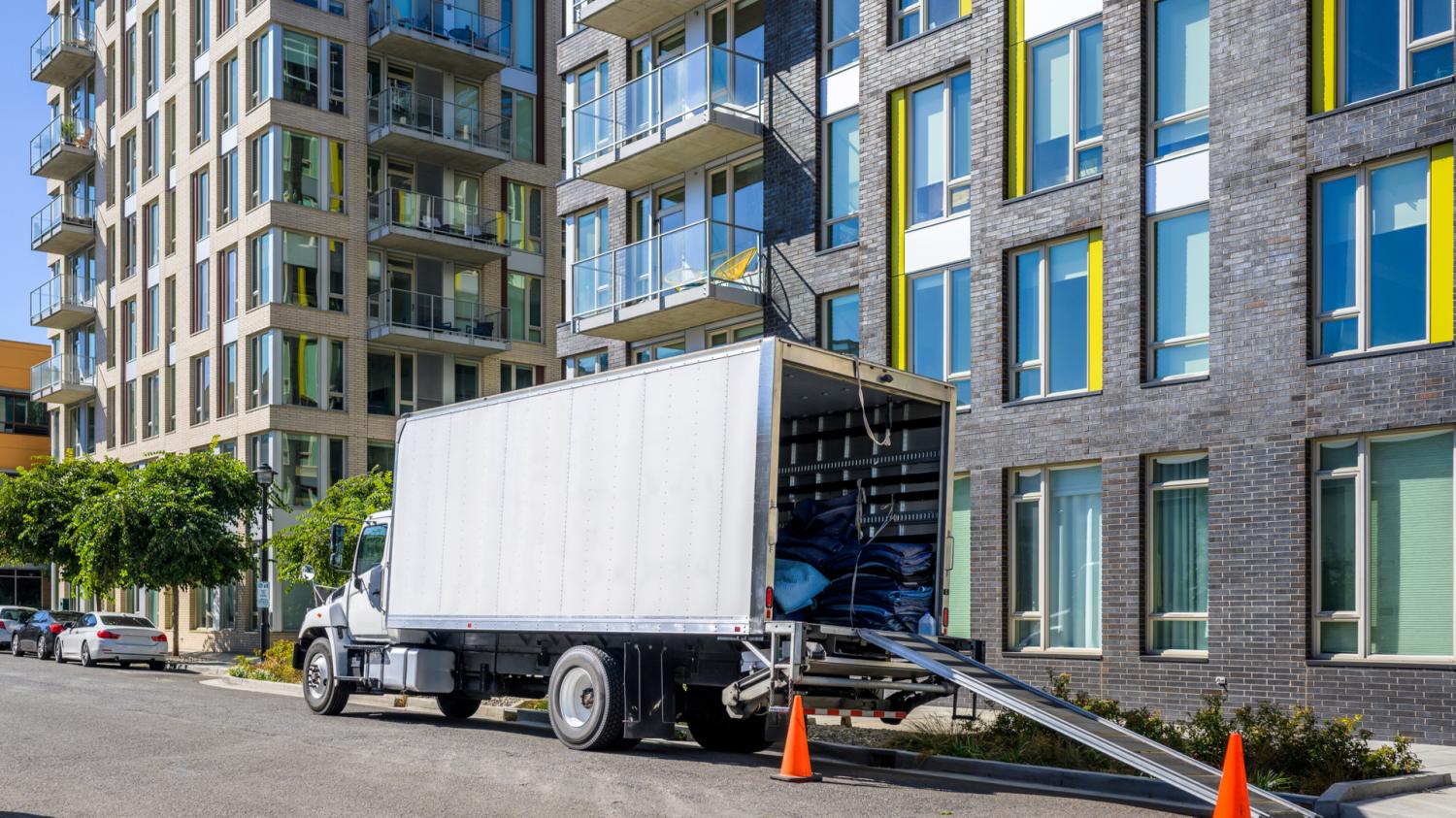New Census Bureau data released this month shows that despite the attention given to COVID-related migration out of cities, college towns, and other pandemic-impacted areas, overall permanent migration levels in the U.S. plummeted to a historically low level during the first year of the pandemic.
Between March 2020 and March 2021, a smaller share of Americans (8.4%) changed residence than in any year since 1947, when the Census Bureau first started collecting annual migration statistics. These statistics do not negate the reporting of pandemic-related permanent or temporary movement for specific areas as suggested by real estate, moving, and survey data. However, during the pandemic, mobility declined enough among broad segments of the population—related to factors such as postponements of births and marriages as well as declining job opportunities—to lead to this historic migration low.
While the decline in national population movement during the pandemic year is noteworthy, it is also a continuation of a decades-long migration decline, as well as a general demographic stagnation across the nation, as revealed in the 2020 census. Yet there is still the possibility that, when the pandemic eventually subsides, “catch-up” migration could occur, perhaps bucking the now long-term decline in the nation’s population movement.
The new migration statistics draw from the Census Bureau’s Current Population Survey Annual Social and Economic Supplement, which has tracked American relocations since 1947. They allow for analyses of different kinds of domestic moves (long distance and short distance) over that 74-year period. These reflect permanent moves wherein persons report different addresses from the year before, thus discounting temporary moves which may have occurred over the course of the year.1
Migration declines during the pandemic accentuated a long-term trend
The drop in U.S. migration from 9.2% in 2019-20 to 8.4% in 2020-21 should be looked at in the context of a fairly consistent decline since the late 1940s to 1960s, when approximately one-fifth of Americans changed residence annually. This was a period of economic growth and robust housing consumption, with a younger population than today. Afterward began a gradual but sustained downturn in migration due to a variety of demographic and economic forces, including the rise of dual-earner households (making them less footloose), an aging population, and more homogenous labor markets emerging across the country. By the late 1990s, only about 15% to 16% of the population moved each year, dropping to 13% to 14% in the early 2000s.
…
Migration dropped even further—to the 11% to 12% range—after the Great Recession, no doubt reflecting the immediate impact of housing and labor market crashes. Since 2012, it has continued dropping to this year’s new low of 8.4%. For three years running, the national migration rate has stood below 10%.
Both short and long distance moves dipped to record lows
It is useful to distinguish between local moves and longer-distance moves. The former tend to be tied to family and housing motivations, whereas employment opportunities play a larger role in the latter. Both showed historic lows in the first pandemic year. Local mobility (defined here as movement within counties) and long distance (across counties) migration rates dipped to 4.9% and 3.3%, respectively. While pandemic considerations impacted these downturns, both have registered declines after the immediate postwar decades, especially since the 2007-09 recession and post-recession periods.
…
As shown in Figure 2a, local mobility hovered in the 8% to 9% range between 2005 and 2010. Since then, it has plummeted to below 5% in the past year. Since 2007 (the first year of the Great Recession), long distance movement has hovered between 3.3% to 3.7%, as shown in Figure 2b. Prior, these levels were 4% or higher—including rates in the 5% to 6% range in the 1990s. Because local moves comprise roughly three-fifths of all moves, their consistent downward trend drove the overall pattern.
Family- and employment-related moves declined during the pandemic
To better understand the downturn in local and long distance moves during the pandemic year, it is possible to examine the different reasons for each type of move. Figure 3 breaks down the number of moves in 2019-20 and 2020-21 into categories: family-related, employment-related, housing-related, and others.2
…
As indicated above, housing- and family-related reasons dominate local moves. This is the case in both years. However, the biggest decline between the two years occurred for family-related moves: from 4.7 million in 2019-20 to 3.7 million in 2020-21. More detailed categories show downturns in moves due to fewer changes in marital status and establishing one’s own household. Declines in housing-related moves were due to fewer people planning to transition from renter to ownership status; among employment-related moves, declines occurred as a result of fewer people moving to a new job or a job transfer.
Among long distance moves, employment- and housing-related moved dominated in 2019-20. However, employment-related moves declined from 3.7 million to 2.6 million between then and 2020-21. In the pandemic year, employment-related moves were less numerous than family- or housing-related moves. The employment-related reasons for moving that saw the largest declines were moving to take a new job and moving to be closer to work.
Youth show the largest pandemic year migration declines
Young adults and children are historically among the most mobile parts of the population. Yet both in the most recent pandemic year and in the years following the Great Recession, these are the groups that showed the largest declines in migration.
…
Figure 4 displays the rates of mobility by age in 2005-06 (the year before the Great Recession) as well as the two most recent years. It makes plain that young adults and children showed the largest declines since pre-Great Recession rates. For example, among young people ages 25 to 29, 27% moved during the 2005-06 period, compared with less than 20% in the two most recent years. This downturn in mobility also affected children under age 15, who are largely the offspring of these young adults.
While downward shifts were not as large between 2019-20 and 2020-21, it is again the youngest age groups that show the greatest dips in migration rates, especially children under age 15 and young adults ages 25 to 29. This suggests that families with children were the most reluctant to move, as well as people in their late 20s who might have been postponing marriage or household formation.
Aside from younger Americans, other demographic groups that showed noticeable declines in migration rates for 2020-21 are renters, persons with low incomes, high school graduates, Latino or Hispanic Americans, men in service jobs, and those employed part time.
Millennials are still stuck in place
Since the Great Recession, the millennial generation—young adults now aged 25 to 40—has borne the brunt of housing and job crises, which has deeply affected their mobility. During this period, they started to occupy a key young adult age group, 25 to 34, which is a launching age for household formation, marriage, and careers. The migration rates of this group continued to stagnate, even more so during the first pandeimc year.
…
When focusing on annual changes in migration rates for 25- to 34-year-olds since before the recession, distinct patterns emerge for both local and long distance migration (see Figures 5a and 5b). They are broadly consistent with overall U.S. trends, and suggest that millennial-infused young adults are the driving force for them. Local migration for this age group dropped from a pre-2010 rate of 14% to 15% to 10% in the year before the pandemic, and down to 9.4% last year. Likewise, long distance migration after 2006 hovered between 6% and 7%, down from rates of 8% or higher before; now, it is down to 5.8%.
Millennials moving into this age group were saddled with “stuck-in-place” issues associated with higher housing costs and underemployment, leading them to postpone key life events such as marriage, childbearing, and homeownership. And even though renters tend to move more frequently than owners, the rental market has become increasingly unaffordable. The new census data shows that annual migration rates of renter households have declined precipitously over time (from 30.2% in 2005-06 to 16.6% in 2020-21).
What’s next?
As the 2020 census revealed, the U.S. was in the throes of a demographic stagnation even before the pandemic hit. Both for the nation and among many local areas, population growth has diminished due to an aging population, more deaths, lower fertility, and a downturn in immigration from abroad. Thus, population movement within the U.S. represents an opportunity for individuals and households to improve their own social and economic well-being, as well as an opportunity for communities of all sizes to attract people who can contribute to their labor forces and consumer and tax bases.
Despite some recent signs of city growth and return migration, the larger picture will depend on the possiblitities afforded to potential movers, especially millennials and Gen Zers entering crucial migration ages as they launch their personal lives and careers. It is possible that there will be some “catch-up” moves among young adult generations whose lives have been put on hold in the past year. Or perhaps the rise of hybrid work will present greater opportunities without needing to relocate.
What we do know is that lower population mobility has been the norm in recent decades and especially the last year. If this continues—thus reinforcing the nation’s continued demographic stagnation—it will likely further reduce the competitiveness and dynamism of America’s housing and labor markets in the years ahead.
-
Footnotes
- Respondents were asked whether or not they resided in the same residence as one year ago. Those who temporarily moved over the course of the year but returned to their original residence are not counted as movers.
- Within these broad categories of reasons to move, more detailed subcategories were also recorded. For example, among family-related moves, subcategories include changes in marital status, establishing one’s own household, and other reasons. Among employment-related moves, subcategories include a new job or job transfer, looking for work, a lost job, moving closer to work/easier commute, retirement, and more. Among housing-related moves, subcategories include wanting to own a home rather than rent, wanting newer/better/larger housing, wanting cheaper housing, foreclosure/eviction, and more.
The Brookings Institution is committed to quality, independence, and impact.
We are supported by a diverse array of funders. In line with our values and policies, each Brookings publication represents the sole views of its author(s).




